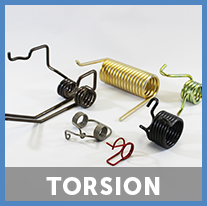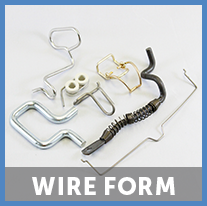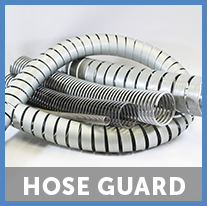Shot peening is a cold working process in which the surface of a spring is bombarded with small spherical media called shot. Each piece of shot striking the surface creates a small indentation or dimple. Overlapping dimples develop an even layer of metal in residual compressive stress. Fatigue cracks will not start or propagate in a compressively stressed zone. When a residual compressive stress is produced in the surface, the tensile stress created by the applied load must first overcome the residual compressive stress before the resultant surface stress becomes tensile.
The results in fatigue life are seen in Figure 1. The example spring is music wire cycled between 22% and 44% of minimum tensile strength. The Goodman diagram (Fig. 1.A.) shows that without shot peen 1 million cycles is doubtful as the dot is right on the 1,000,000 cycle line. Figure 1. B. shows that with shot peen the stress is well within the limit for 10,000,000 cycles.
 |
 |
| Fig. 1.A. before shot peen | Fig. 1.B. after shot peen |
Next, Figure 2. illustrates how this improvement in cycle life is possible. A distribution of compressive stress is shown in a typical peened surface with no external load applied. (Fig. 2.A.) Because compressive stress has been produced at the surface, an offsetting tensile stress is developed in the core.
For the part to be in equilibrium, the total area of the region in compression must be equal to the area in tension. When an external bending stress is applied (Fig. 2.B.), the resultant stress at any depth must equal the algebraic sum of the residual and the applied stress.
The resultant stress (solid line) defines the stress distribution thru the section while under load. In this example, the surface remains in compressive stress even though the section is under load. If even higher stresses are applied, the resultant curve would shift to the left, perhaps into tensile at the surface. However, the tensile stress will be far lower than if the surface had not been peened.
 |
 |
| Fig. 2. Compressive stress induced in the peened surface of a shotpeened beam (A) prevents tensile stresses from occurring after a bending moment is applied to the part. | |
To achieve the maximum benefit from shot peening, it is important to carefully control the shot peening parameters. Each spring must be peened with the proper size and hardness shot and to an appropriate Almen intensity. The springs need to be peened to 100% coverage and full saturation. Saturation is defined as the point at which doubling the peen time produces no more that a 10% increase in Almen intensity.
Rockford Spring can shot peen medium wire size springs. For smaller wire, we recommend sending out to Metal Improvement Company, Inc. Contact Rockford Spring for your specific case.
For even better results, dual shot peening is sometimes used. This process involves first peening with a larger shot and then repeening with a smaller shot. The larger shot can drive the compressive stress layer deeper into the surface and the smaller shot can actually achieve a higher compressive stress right at the surface. The combination has been shown to improve fatigue life over one shot size by itself. The added cycle life does of course come at a higher price.
A special thanks to Metal Improvement Company for providing information and illustrations used on this web page.






